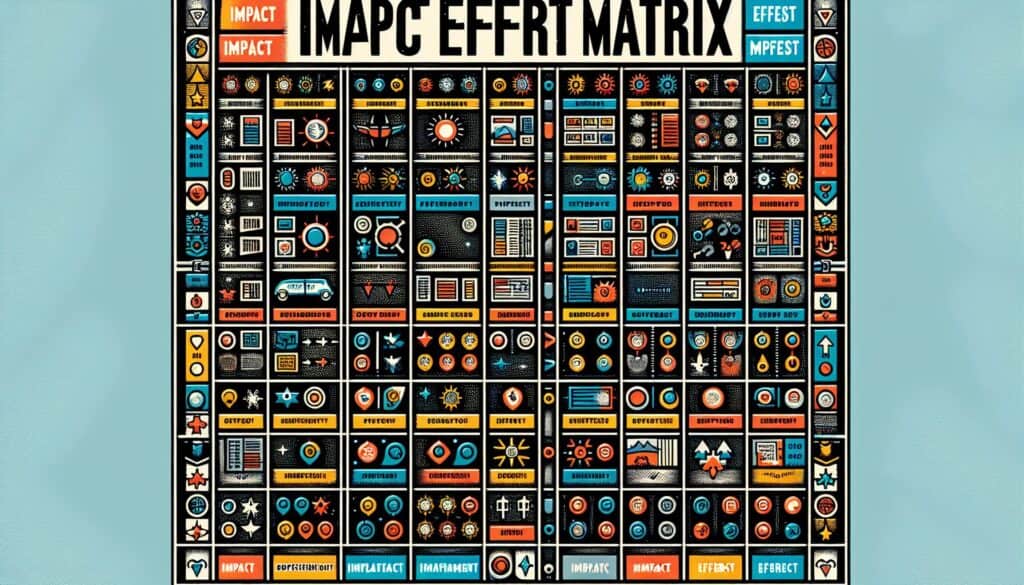Hiérarchiser les tâches ou les initiatives en fonction de leur impact potentiel et de l'effort nécessaire pour les mettre en œuvre.
- Méthodologies : Clients et marketing, Économie, Conception de Produits
Matrice de l'impact et de l'effort

Matrice de l'impact et de l'effort
- Méthodologie Agile, Amélioration continue, Pensée conceptuelle, Production allégée, Gestion de projet, Gestion de la qualité, Scrum, Pratiques de durabilité, Cartographie de la chaîne de valeur
Objectif :
Comment il est utilisé :
- Une grille 2x2 où un axe représente l'impact (par exemple, élevé/faible) et l'autre l'effort (par exemple, élevé/faible). Les éléments sont reportés sur la matrice afin d'identifier les gains rapides (impact élevé, effort faible), les projets majeurs (impact élevé, effort important), les tâches complémentaires (impact faible, effort faible) et les tâches ingrates (impact faible, effort important).
Avantages
- Simple et visuel ; facilite la prise de décision rapide et l'établissement de priorités ; aide les équipes à se concentrer sur les activités présentant le meilleur retour sur investissement ; encourage la discussion et le consensus sur les priorités.
Inconvénients
- Subjectivité dans l'évaluation de l'impact et de l'effort ; peut simplifier à l'excès des décisions complexes ; ne tient pas compte des dépendances entre les tâches ou de l'alignement stratégique sans contexte supplémentaire.
Catégories :
- Idéation, Résolution de problèmes, Gestion de projet
Idéal pour :
- Classer rapidement par ordre de priorité une liste d'idées, de projets ou de tâches afin d'identifier ce sur quoi il faut se concentrer en premier.
The Impact Effort Matrix is commonly employed in various industries including software development, product management, and engineering, particularly during the ideation and planning phases of projects. This methodology aids teams in evaluating potential initiatives by visualizing which tasks could lead to significant benefits with minimal resource investment, allowing for efficient allocation of efforts. In software development, for example, a team might identify user interface enhancements that could improve customer satisfaction significantly while requiring little coding effort, thus categorizing them as quick wins. Conversely, a manufacturing firm might plot a new product line launch that promises high returns but demands extensive R&D and market validation, positioning it within the major projects quadrant. Stakeholders from cross-functional teams, including marketing, design, and engineering, typically contribute to this exercise to leverage diverse insights and foster collective decision-making. The visual nature of the matrix facilitates discussions that can align team members on priorities, ultimately driving a consensus on which initiatives should receive immediate attention to maximize efficiency and effectiveness in project execution. This approach not only accelerates decision-making but also improves transparency in the prioritization process, ensuring that team efforts are concentrated where they can yield the most substantial impact.
Principales étapes de cette méthodologie
- Define criteria for impact and effort based on project goals.
- List ideas, projects, or tasks that need prioritization.
- Assess and assign impact and effort scores to each item.
- Plot the items on the 2x2 grid based on their scores.
- Identify and categorize items in the quadrants: quick wins, major projects, fill-ins, and thankless tasks.
- Discuss and prioritize actions based on the visual representation of the grid.
- Determine next steps for implementing the prioritized items.
Conseils de pro
- Incorporate stakeholder feedback in the matrix creation process to align project priorities with organizational goals.
- Regularly update the matrix as new data or insights emerge, ensuring that your prioritization reflects current market conditions and customer needs.
- Utilize color-coding or tagging on the matrix for different team members or departments to visually represent responsibility and improve collaborative discussions.
Lire et comparer plusieurs méthodologies, nous recommandons le
> Référentiel méthodologique étendu <
ainsi que plus de 400 autres méthodologies.
Vos commentaires sur cette méthodologie ou des informations supplémentaires sont les bienvenus sur le site web de la Commission européenne. section des commentaires ci-dessous ↓ , ainsi que toute idée ou lien en rapport avec l'ingénierie.
Contexte historique
1960
1980
1983
1990
1995
2000
2010
1950
1980
1980
1986
1994
1995
2000
(si la date est inconnue ou n'est pas pertinente, par exemple "mécanique des fluides", une estimation arrondie de son émergence notable est fournie)














Articles Similaires
Questionnaires sur les troubles musculo-squelettiques
Tests à plusieurs variables (MVT)
Analyse de régression multiple
Systèmes de capture de mouvement
Méthode MoSCoW
Test de la médiane de Mood